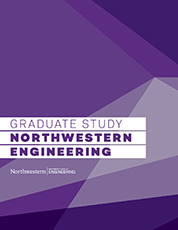Anthony Jakubiak Gives Back to EDI Community
The EDI alum, who currently works as Executive Design Director at Chase, recently participated in a New York City panel discussion for EDI students.
When Anthony Jakubiak (EDI '12) was a student in Northwestern's Engineering Design Innovation (EDI) program, he benefited from the support and encouragement of EDI alumni.
Today, Jakubiak is the Executive Design Director at J.P. Morgan Chase, where he helps build the next generation of financial digital products and services. Prior to that, he spent six years at enterprise software company SAP in multiple design roles.
Soon after he graduated, he quickly found ways to give back to the program that gave him so much. He talks with EDI students about his time in the program and his own professional experiences. He is an adjunct professor at Northwestern's San Francisco campus, where he teaches undergraduate and graduate studio design courses.
Earlier this year, Jakubiak participated in a panel discussion for current EDI students visiting New York City as part of the seventh annual Integrated Design Innovation (IDI) gathering.
After the event, he took time to talk about the lessons he hoped students took away from the event, as well as why EDI was so important to his professional development.
Why was it important for you to participate on the panel?
For me, EDI alumni gave me so much education and insight when I was a student that helped me find my way. I try to pay that back to close the loop.
What were two or three lessons you hope students took away from you and your experiences?
- EDI is a unique, once-in-a-life experience. Take advantage of the amazing faculty, courses, events, network, and educational environment while you can, as it will never be so easy to have those things once you're working.
- EDI exposes you to the many facets of human-centered-design and to various design depths, like design research, interaction design, service design, product design and interactions, user experience, methods, and so on. Find where you want to play within the design field and have a strong point of view around that. Don't try to say you do everything within design.
- Don't put so much pressure on your summer internships. Any experience within the design field over the summer is going to yield incredible learnings and growth to build off of.
Why is it important for EDI to offer experiences like this to students?
The exposure to different design markets outside of Chicago and to connect with other like-minded students, alumni and companies that you will inevitably cross-paths with throughout your design career.
What was it about EDI that first appealed to you when you were applying?
- The experiential, "real-life" component to all of the course work. Almost all classes had a hands-on project aspect and client component to give realism to what I might experience after graduating.
- The fact that most faculty came from industry and not pure academia.
- The breadth in design coursework offered to expose yourself and allow you to find where you truly want to play.
How would you describe your EDI experience?
Incredible. Life changing. The exposure to amazing faculty who were seasoned design practitioners and the opportunity to work with incredible client partners on fascinating design challenges was amazing. We had a close-knit cohort where I formed life-long friendships. I was able to complete exciting coursework offered by the Segal Design Institute and had the ability to go cross-disciplinary in my courses, which meant I could take courses at the Kellogg School of Management or Medill School of Journalism, Media, Integrated Marketing Communications, among others, in order to gain exposure to other graduate fields and students I could likely be interacting with post graduation.
What are the most important things you learned during your time in the program?
There were too many to count. Here are a few things:
- How to build to think and have a bias toward action no matter if it's physical, digital or service. Segal ingrains a maker culture in all of its students.
- How every design decision should be grounded in an understanding of who your users are
- How to design for delight and also for business.
- Client project work delivery.
How are you able to incorporate your EDI experience into your day-to-day job today?
- I would say all of my answers to the previous question are mindsets EDI gave me that I use in my job every day. EDI also taught me how to have an instinct to know when you have spent enough time in the design process and need to move the project forward.
Is there anything else you'd like to add?
I would have never gotten to where I am today in my career without EDI. That year-and-a-half I experienced at EDI was the most profound period of growth and learning. It was the happiest time in my life. EDI allowed me to find and hone my passion and unleash my skills to enable me to transition into the career I always wanted. I was a civil engineer in my former life, and EDI equipped me with a whole-brain mindset that has been invaluable post-graduation.
I also feel incredibly grateful that I have been able to stay connected to the EDI community so much since graduation. You will always be welcomed at Segal with open arms as alumni and it is a community and family you will have for life. It has also been a pure joy to have the opportunity to come full-circle and teach courses in design for Northwestern that I once took (Jakubiak teaches undergraduate and graduate studio design courses at Northwestern's San Francisco campus for the Segal Design Institute and Medill School of Journalism).

